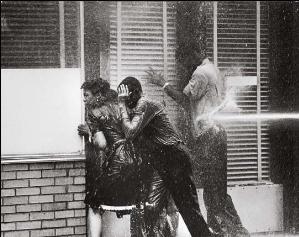Birmingham campaign
| Birmingham campaign | |||
|---|---|---|---|
| Part of the Civil Rights Movement | |||

High school students are struck by a high-pressure water jet from a fire hose during a peaceful walk in Birmingham, Alabama in 1963. As photographed by Charles Moore, images like this one, printed in Life, inspired international support for the demonstrators.
|
|||
| Date | April 3 – May 10, 1963 (1 month and 1 week) |
||
| Location | Birmingham, Alabama and Kelly Ingram Park | ||
| Causes |
|
||
| Result |
|
||
| Parties to the civil conflict | |||
|
|||
| Lead figures | |||
|
|||
ACMHR member
SCLC members
City Commission
Chamber of Commerce
The Birmingham campaign, or Birmingham movement, was a movement organized in early 1963 by the Southern Christian Leadership Conference (SCLC) to bring attention to the integration efforts of African Americans in Birmingham, Alabama. Led by Martin Luther King Jr., James Bevel, Fred Shuttlesworth and others, the campaign of nonviolent direct action culminated in widely publicized confrontations between young black students and white civic authorities, and eventually led the municipal government to change the city's discrimination laws.
In the early 1960s, Birmingham was one of the most racially divided cities in the United States, both as enforced by law and culturally. Black citizens faced legal and economic disparities, and violent retribution when they attempted to draw attention to their problems. Martin Luther King Jr. called it the most segregated city in the country. Protests in Birmingham began with a boycott led by Shuttlesworth meant to pressure business leaders to open employment to people of all races, and end segregation in public facilities, restaurants, schools, and stores. When local business and governmental leaders resisted the boycott, SCLC agreed to assist. Organizer Wyatt Tee Walker joined Birmingham activist Shuttlesworth and began what they called Project C, a series of sit-ins and marches intended to provoke mass arrests.
When the campaign ran low on adult volunteers, James Bevel, SCLC's Director Direct Action, thought of the idea of having students become the main demonstrators in the Birmingham campaign. He then trained and directed high school, college, and elementary school students in nonviolence, and asked them to participate in the demonstrations by taking a peaceful walk fifty at a time from the 16th Street Baptist Church to City Hall in order to talk to the mayor about segregation. This resulted in over a thousand arrests, and, as the jails and holding areas filled with arrested students, the Birmingham Police Department, led by Eugene "Bull" Connor, used high-pressure water hoses and police attack dogs on the children and adult bystanders. Not all of the bystanders were peaceful, despite the avowed intentions of SCLC to hold a completely nonviolent walk, but the students held to the nonviolent premise. King and the SCLC drew both criticism and praise for allowing children to participate and put themselves in harm's way.
...
Wikipedia
